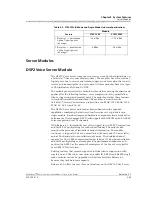
255-700-019
3-63
PacketStar
™
PSAX 20 Access Concentrator User Guide
, Issue 1
Release 6.3.0
Chapter 3 System Features
Multi-Serial Module
Circuit Emulation
Each port on the Multi-Serial module can be configured to perform
adaptation for circuit emulation. The implementation of ATM Adaptation
Layer 1 (AAL-1) allows for the transmission of circuit emulation data as
Constant Bit Rate (CBR) traffic across an ATM network. With circuit
emulation support, the Multi-Serial module can adapt and concentrate
circuit emulation traffic onto an ATM network. This feature enables the
Access Concentrator system to interface with non-frame relay routers, video
encoders, encryption devices, and other devices which use a synchronous
interface.
Terminal Emulation
Each port on the Multi-Serial module can be configured to perform an
adaptation for terminal emulation. The implementation of ATM Adaptation
Layer 5 (AAL-5) allows for the transmission of terminal emulation data as
Variable Bit Rate (VBR) traffic across an ATM network. With terminal
emulation support, the Multi-Serial module can adapt and concentrate
terminal emulation traffic onto an ATM network. This feature enables the
Access Concentrator system to interface with terminal equipment such as
monitors, craft interfaces, console ports, sensors, and other devices
implementing an asynchronous interface.
HDLC Pass-through
Each port on the Multi-Serial module can be configured to perform
adaptation for high-level data link control (HDLC) pass-through. Without
this feature, AAL-1 adaptation would be required for data from HDLC
devices connected to a port on the Multi-Serial module. With this feature,
AAL-5 adaptation can be used to allow HDLC data to be handled as if it were
VBR rather than CBR. Since ATM cells are only generated when HDLC is
present, optimal bandwidth is utilized.
ATM
Each port on the Multi-Serial module can be configured for ATM service as
per the ATM Forum’s UNI 3.0/3.1 specifications. With this feature, a port on
the Multi-Serial module can be used as an ATM network interface, using the
LANET protocol.
With this feature, statistical multiplexing gains can be achieved over low
speed serial links. By using LANET, the advantages of ATM can be used over
serial links to optimally interleave traffic for efficient bandwidth utilization
and multi-media capability. The LANET protocol efficiently adapts ATM to
low speed, high noise applications such as wireless and satellite. It is a
physical layer protocol that maintains cell extraction capability at bit-error
rates up to 10 to the negative second power (-2). LANET overhead accounts
for 0.63% of link bandwidth. It can be implemented over each of the
supported serial interface types, and is independent of the transmission rate.
Hardware Features
•
Number of ports: six serial
•
Connector type: micro-DB15
Summary of Contents for PacketStar PSAX 20
Page 399: ......
















































